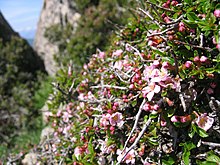| Prunus prostrata | |
|---|---|

| |
| Conservation status | |
 Least Concern (IUCN 3.1) | |
| Scientific classification | |
| Kingdom: | Plantae |
| Clade: | Tracheophytes |
| Clade: | Angiosperms |
| Clade: | Eudicots |
| Clade: | Rosids |
| Order: | Rosales |
| Family: | Rosaceae |
| Genus: | Prunus |
| Subgenus: | Prunus subg. Prunus |
| Section: | Prunus sect. Microcerasus |
| Species: | P. prostrata |
| Binomial name | |
| Prunus prostrata Labill. (1791) | |
| Synonyms | |
| |
Prunus prostrata (mountain cherry, rock cherry, creeping cherry, spreading cherry or prostrate cherry) is a hardy alpine shrub found naturally above about 2000 m. up to as high as 4000 m. in Spain, France, Algeria, Morocco, Tunisia, Albania, Croatia, Greece, North Macedonia, Sardinia, Turkey, and Syria. It grows as tall as 1 m., more typically 0.15-0.30 m., sometimes in the crevices of vertical surfaces. The branches tend to follow the surface at any angle. Flowering patches of the plant on the rocky slopes, sometimes still snow-clad, are striking to climbers.
The bark is reddish brown. The leaves are ovate, with serrate margins, tomentose with white down on undersurface, glabrous above. The petioles lack glands. The flowers are an unusual light rose color, coming out in April–May, solitary or in pairs, nearly sessile, with a tubular calyx. There are 22-24 stamens. The fruit is red, ovate, with thin flesh, ripening in July.
Uses
The fruit is edible but not preferred by humans. The plant's main use is as in ornamental gardening. It can be grafted to form a tree.
Classification
The name Prunus prostrata was assigned by Jacques Labillardière, the French botanist, in Icones plantarum Syriae rariorum, published on his return from a plant-hunting expedition to the Middle East. Prostrata means "lying on the ground", referring to the plant's ground-hugging propensity, a mechanical necessity at high elevation. A prostrate branch bends back to the ground.
Palaeobotanical evidence
A recent study of pollen and other microfossils from a core sample taken in an intermontane valley of the Segura mountains in southern Spain finds P. prostrata in a "Prunus type" located in two radiocarbon-dated zones from about 2630 BP to about 1550 BP and again from about 790 BP to present. The ecology of the Prunus type was "high-altitude open pine forest." The core goes back to 8320 BP, but there is no evidence if Prunus in it before 2630.
References
- Maxted, N.; Rhodes, L. (2016). "Prunus prostrata". IUCN Red List of Threatened Species. 2016: e.T172276A48417319. doi:10.2305/IUCN.UK.2016-3.RLTS.T172276A48417319.en. Retrieved 18 November 2021.
- Note: Mountain cherry is also one of many names used for Prunus tomentosa.
- Note: Rock cherry also has been used for Prunus mahaleb.
- "Prunus prostrata". Germplasm Resources Information Network. Agricultural Research Service, United States Department of Agriculture. Retrieved 17 May 2024.
- "Prunus prostrata Mountain Cherry PFAF Plant Database".
- La Billardière, Jacques-Julien Houtou de (1791). Icones plantarum Syriæ rariorum, descriptionibus et observationibus illustratæ Vol. 1. Lutetiæ Parisiorum: Impensis Autoris pp. Tabula (t.) 6, page 15. This rare and expensive book is in the process of or recently has been reprinted. The botanical designation of the plant is Prunus prostrata Labill. (subg. Prunus sect. Microcerasus); of the book, Icon. pl. Syr. 1:15, t. 6. 1791.
- Carrión, J.S.; Munuera, M.; Dupré, M.; Andrade, A. (2001). "Abrupt vegetation changes in the Segura Mountains of southern Spain throughout the Holocene". Journal of Ecology. 89 (5): 783–797. doi:10.1046/j.0022-0477.2001.00601.x. See the tables on pages 789 & 792.
- For simplicity the tolerances have not been repeated here. "Present" is 1955/1956 AD.
External links
- "Prunus prostrata". Plants for a Future.
- Scott, David (1997). "Prunus prostrata". Photoflora. Archived from the original on 2008-06-27. Retrieved 2007-09-11.
- Old Dominion University (2002). "PLANT SITE: Prunus prostrata Rosaceae".
| Taxon identifiers | |
|---|---|
| Prunus prostrata |
|
| Cerasus prostrata | |